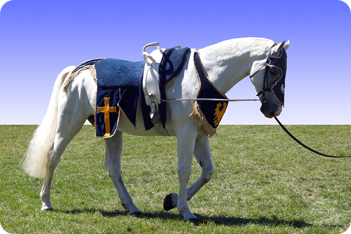
Horse Competitions
Vaulting
From: Horse Competitions

Vaulting
Vaulting has been an International sport since about 1983 and it involves the rider, either as an individual or as part of a team, performing gymnastic exercises on a lunge horse who is being controlled by the lunger.
The sport of vaulting is open to both men and women who can compete individually or as part of a team with the movements performed being marked out of 10 with classes ranging from walk classes to the higher levels where the horse remains in canter for the whole of the routine.
Vaulting Exercises Performed
The horse, lunger and vaulter are judged as a team, with a number of specific exercises having to be performed in the compulsory tests in a set order. During the freestyle competition a more varied routine is performed but with the order and choice of exercise being left up to the vaulter or team. Some of the set movements that are performed and a brief description are listed below:
- The Mount - The vaulter stands with the person lunging in the center of the circle and runs towards the horses shoulder picking up a canter motion, the vaulter then takes hold of the handles and prepares to mount jumping off both feet and lifting their hips and outside leg as high as possible and then lowering the outside leg so that the vaulter is sitting astride the horse just behind the surcingle. The mount should be smoothly done in balance and rhythm with the horse with the vaulter landing as softly as possible on the horse back.
- Basic Seat - The rider sits astride the horse and raises and extends both of their arms in a straight line so that the vaulters fingertips are at eye level with palms down and fingers closed, with lower leg should remain straight down in alignment with the riders ear.
- Flag - The vaulter begins in the seat astride position and then lightly kneels behind the surcingle before carefully stretching out both the inside arm and outside leg into an arc with hips and shoulders remaining at the same level, this is held for four canter strides before the grip is retaken and seat astride position returned.
- Mill - The rider turns a complete 360 degree's by bringing one leg up as straight and as high as possible while the other leg remains straight down and in complete contact with the horses side.
- Scissors - The rider lifts their body and legs high and twist to turn around to face into the opposite direction which is followed by a repeat of the exercise in order to return to the original position astride the horse.
- Stand - During the stand position the vaulter starts off in seat astride before swinging into the kneeling position, then the vaulter springs onto their feet and rise into the standing position keeping legs close together followed by raising their arms so that the fingertips are again level with the vaulters eyes, this standing position is held for four canter strides before the seat astride position is returned.
- Flank - This is the dismount which is performed to the outside of the lunge circle.
The Vaulter
Natural balance and gymnastic skills are required, practice often begins on a wooden horse which allows the individual or team to practice before the movements are put into practice on the horse. During competition the vaulters often wear full body leotards to allow for ease of movements and are usually matching or theme in line with the vaulters choice of music and vaulting shoes which are soft yet provide grip.
Vaulting Horse
For vaulting the horse needs to be exceptionally well mannered and well schooled to be able to maintain balance and rhythm whilst on a 15 meter lunge circle. The horse is also judged on its movement on the lunge and for its behavior. During competition the horse wears a bridle and cavesson which the lunge line is attached to, as well as a surcingle which has handles and stirrups for the vaulters to use. Over the horses back underneath the surcingle is a large saddle pad for protection and there are also the side reins which attached to the surcingle and clip onto the bridle.
Types Of Vaulting Competition
There are three types of competition available to Vaulters which are Individual, Pairs or Team events.
- Individual - vaulters must perform a compulsory test and a freestyle test to qualify them to ride in the final round, in CVI1* the freestyle and compulsory tests are repeated in the final and for the CVI2* a technical and freestyle test have to be performed.
- Pairs - this is known as a pas-de-deux and involves two riders competing over one or two freestyle rounds.
- Team Events - six vaulters, a lunger and a horse make up a team with the addition of a seventh vaulter added if necessary. Team competitions require a six minute compulsory test and a four minute freestyle test in order to qualify them for the second or final round, where a freestyle test will be ridden.
FEI Competitions
- World Equestrian Games are held every four years.
- World Championships are also held every four years.
- European Vaulting Championships are held every two years.